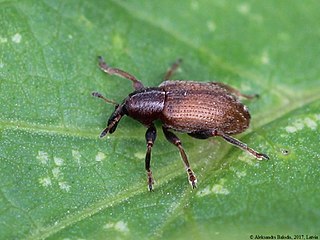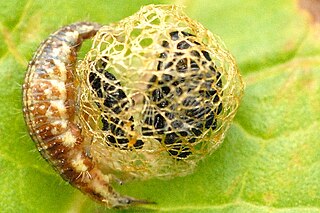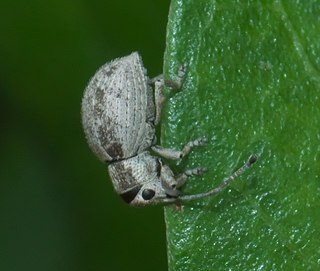
Hypera meles, the clover head weevil, is a species of true weevil in the beetle family Curculionidae. It is found in North America and Europe.

Hypera diversipunctata is a species of true weevil in the beetle family Curculionidae. It is found in North America and Europe.
Rhigopsis is a genus of broad-nosed weevils in the beetle family Curculionidae. There are at least two described species in Rhigopsis.

Hypera rumicis is a species of true weevil in the beetle family Curculionidae. It is found in North America and Europe.
Hypera brunnipennis, the Egyptian alfalfa weevil, is a species of true weevil in the beetle family Curculionidae. The name is often misspelled as brunneipennis in the literature.
Hypera compta is a species of true weevil in the family of beetles which is known as Curculionidae. It is found in North America.
Plinthodes is a genus of broad-nosed weevils in the beetle family Curculionidae. There are at least two described species in Plinthodes.
Laemosaccus is a genus of true weevils in the beetle family Curculionidae. There are at least 130 described species in Laemosaccus.

Otiorhynchus ligustici, known generally as the alfalfa snout beetle or lovage weevil, is a species of broad-nosed weevil in the family Curculionidae. It is found in North America and Europe.

Rhyncolus is a genus of true weevils in the beetle family Curculionidae. There are at least 140 described species in Rhyncolus.
Pachylobius is a genus of pine weevils in the beetle family Curculionidae. There are at least two described species in Pachylobius.
Dorytomus rufulus is a species of true weevil in the beetle family Curculionidae. It is found in North America.

Tanymecus is a genus of broad-nosed weevils in the beetle family Curculionidae. There are at least 100 described species in Tanymecus.
Stamoderes is a genus of broad-nosed weevils in the beetle family Curculionidae. There are at least two described species in Stamoderes.
Dorytomus hystricula is a species of true weevil in the beetle family Curculionidae. It is found in North America.
Parenthis is a genus of minute seed weevils in the beetle family Curculionidae. There is at least one described species in Parenthis, P. vestitus.
Pnigodes is a genus of true weevils in the beetle family Curculionidae. There is at least one described species in Pnigodes, P. setosus.
Microhyus is a genus of true weevils in the beetle family Curculionidae. There is at least one described species in Microhyus, M. setiger.
Thinoxenus is a genus of broad-nosed weevils in the beetle family Curculionidae. There is at least one described species in Thinoxenus, T. squalens.

Neoptochus is a genus of oriental broad-nosed weevils in the beetle family Curculionidae. There is at least one described species in Neoptochus, N. adspersus.








